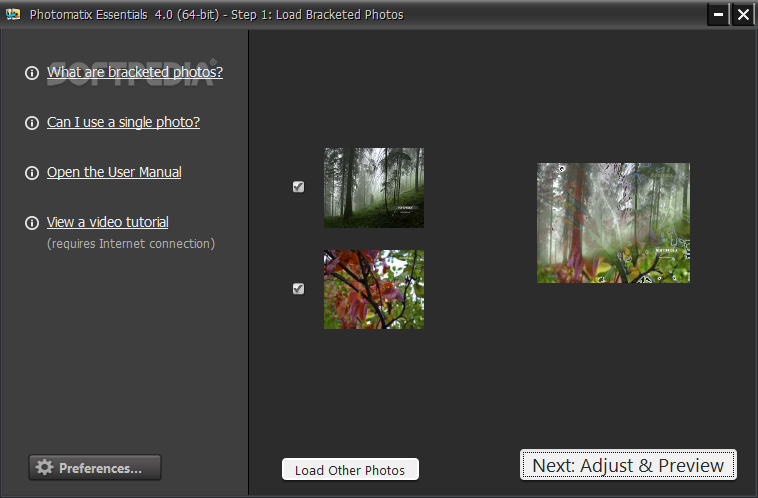

- #PHOTOMATIX ESSENTIALS SINGLE PHOTO HOW TO#
- #PHOTOMATIX ESSENTIALS SINGLE PHOTO MANUAL#
- #PHOTOMATIX ESSENTIALS SINGLE PHOTO ISO#
#PHOTOMATIX ESSENTIALS SINGLE PHOTO ISO#
Select a low ISO, such as ISO 100 or lower.Set your camera to Aperture priority (“A” setting) so that only the shutter speed varies between the exposures.HDR photography requires that you set up your camera a bit differently than normal: All it takes is a different mindset than traditional photography, which emphasizes taking and editing a single photo, independent from any others. With that data in hand, Photomatix Essentials can merge the diferent photos and process them to rescue details from shadows and keep highlights from blowing out.Īside from that practical rationale, HDR photography offers photographers and photo editors a new and powerful tool with which to take and “develop” their photographs and present them in a unique and inspirational way. HDR photography solves these problems by taking enough photos (traditionally 3) to contain the entire exposure range of the scene. Lost detail in shadows: Conversely, when bright areas of a scene are protected (by lowering exposure), there is not enough light to register details on the camera’s sensor in dark areas of the scene.They “blow out” and turn white because they have very little or no usable data in them. Blown highlights: When the exposure is raised to make sure the foreground or subject is properly exposed, brighter areas of the scene suffer.This results in two main problems (which sometime happen together in the same photo): In other words, today’s digital camera can’t properly expose everything at the same time in scenes with even moderate contrast ratios. The central premise of HDR photography is that there are very few situations where a single photograph can capture the true dynamic range (the total range of light in a scene, from very dark to very light) of a scene accurately. Section 1: HDR (High Dynamic Range) photography
#PHOTOMATIX ESSENTIALS SINGLE PHOTO MANUAL#
At the end of the manual is a glossary of some of the terms associated with HDR.
#PHOTOMATIX ESSENTIALS SINGLE PHOTO HOW TO#
The third section explains how to use the Image Alignment, Ghost Removal and Noise Reduction features offered by Photomatix Essentials. The second section is a detailed tutorial on how to use Photomatix Essentials. The first section is a general description of HDR photography and how to shoot it. This manual is organized into three major areas. Photomatix Essentials processes multiple exposure bracketed photos into a single image either by a process known as fusing the exposures together or through a process known as HDR (High Dynamic Range) tone mapping.

Īdjusting the Image with Fusion or Tone Mapping (Step 2)


 0 kommentar(er)
0 kommentar(er)
